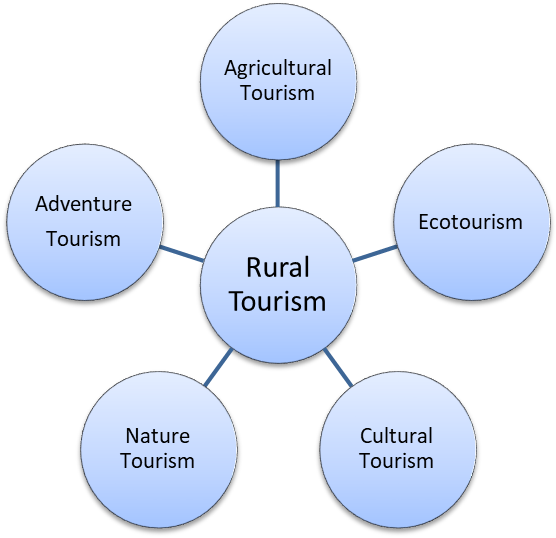Rural Tourism
2023 MAR 3
Mains >
Economic Development > Indian Economy and issues > Tourism
IN NEWS:
- Central nodal agency – Rural Tourism and Rural Homestays (CNA-RT & RH) , under the Ministry of Tourism has identified six niche experiences for tourists wanting to visit rural India, including agritourism, art and culture, ecotourism, wildlife, tribal tourism, and homestays.
WHAT IS RURAL TOURISM?
- Any form of tourism that showcases the rural life, art, culture, and heritage at rural locations, thereby benefiting the local community economically and socially as well as enabling interaction between the tourists and the locals for a more enriching tourism experience can be termed as rural tourism.
- Rural Tourism focuses on the visitor actively participating in a rural lifestyle.
- The tourist travels to a rural location and experiences the life while taking part in the daily activities of the village.
- The tourist also gets a chance to imbibe the traditions and culture of the area.
-------------------------------------------
SIGNIFICANCE OF RURAL TOURISM:
- Provide alternative to overcrowded tourist destinations:
- Rural tourism offers an alternative to busy urban tourist destinations, allowing tourists to enjoy a healthier and more culturally enriching experience in the villages.
- By absorbing some of the tourist influx, it can also serve as a buffer during times of overcrowding in popular tourist destinations.
- Promote sustainable and responsible tourism:
- Rural tourism, exhibiting the unique experiences of Indian villages and closely related niche areas of tourism such as eco-tourism, farm-tourism, adventure tourism etc., provides a great opportunity to promote sustainable and responsible tourism in the country.
- Poverty alleviation and sustainable development in rural areas:
- The villages are repositories of the country’s culture, tradition, crafts, heritage, and agricultural practices.
- Developing and promoting these local products through tourism can generate income and jobs in rural areas and empower local communities, youth, and women, fulfilling the vision of Aatmanirbhar Bharat.
- This will help in reducing the distress migration from rural areas, poverty alleviation, and sustainable development.
- Revitalize local art and crafts:
- Rural tourism can revitalise local arts and crafts and prevent viable traditional occupations from being displaced.
- It will help redevelop rural areas and rejuvenate rural life. The interaction with the visitors will expand their knowledge and horizons.
CONCERNS AND CHALLENGES:
- Environmental impacts:
- Rural tourism will require infrastructure, transportation, and other facilities that can cause environmental distortion.
- Also, the visitors may overexploit natural resources and it can have a heavy impact on the environment.
- Tourist activities like trekking and camping can cause environmental pollution.
- Development of infrastructure may distort the natural beauty. For instance, high rise building for tourist can spoil the scenic beauty.
- May affect the traditional and cultural practices:
- Poorly planned tourism can affect the villagers. It can disrupt rural culture. It may affect traditional and cultural practices, agriculture, and other allied activities.
- For example, rural people may shift from traditional business to tourism activities, traditional houses may be replaced by modern buildings.
- Lack of awareness and knowledge:
- Rural populations are less familiar with the concept of cultural and rural tourism.
- Also, they lack knowledge about how to market their cultural, artistic, and craft-related services to tourists.
- Infrastructural constraints:
- Poor transportation facilities, insufficient infrastructure, and inadequate lodging would hinder the development of tourism in rural areas.
- Lack of trained manpower:
- The trained people in hotel management may not be interested in going to a rural area to work.
- The rural people who will be appointed are required to be trained in discharging their duties.
GOVERNMENT INITIATIVES:
- Pilgrimage Rejuvenation and Spiritual Augmentation Drive (PRASAD):
- It focuses on identifying and developing the pilgrim sites across the country to enrich the religious tourism experience.
- Pilgrimage and rural tourism have been interlinked and complement each other in generating employment and developing peripheral infrastructure.
- Swadesh Darshan Scheme:
- It aims to develop theme-based tourist circuits in the country.
- Vibrant Villages Program:
- The scheme will provide funds for development of essential infrastructure and creation of livelihood opportunities in 19 Districts and 46 Border blocks 4 states and 1 UT along the northern land border of the country which will help in achieving inclusive growth and retaining the population in the border areas.
- To boost tourism in border villages, the government will facilitate tourism infrastructure and amenities through the Vibrant Villages Program.
- The Government is also exploring organic agriculture areas developed under the Paramparagat Krishi Vikas Yojana (PKVY) and Mission Organic Value Chain Development in North East Region (MOVCD-NER) for development as rural tourist spots.
WAY FORWARD:
- Clusters for rural tourism:
- There is a need to identify suitable clusters of 5–7 villages in close vicinity for promoting rural tourism.
- A cluster will offer more tourist attractions than rural tourism projects of individual villages separated by long distances.
- Further, marketing of local products of a group of villages can be facilitated by holding Craft bazaars or haats. The clusters can also converge other programs for skills, capacity building, marketing etc.
- Public private partnership:
- Apart from the existing central and state schemes, which can be used in convergence to meet the requirement of implementation of development plans for rural tourism, suitable public private partnership models should also be developed to encourage the private sector to join hands for the development of rural tourism.
- Infrastructure development:
- As the quality of transportation facilities and basic tourist infrastructure is often substandard and unreliable in many rural areas, there should be efforts to develop community-based tourism infrastructure and attract public-private partnerships.
- Also, multi-modal connectivity in line with Gati Shakti should be launched to provide seamless connectivity to rural tourism sites.
PRACTICE QUESTION:
Q. “Rural tourism can play a crucial role in promoting local economic growth and bringing about social transformation”. Discuss the significance and challenges associated with rural tourism.
